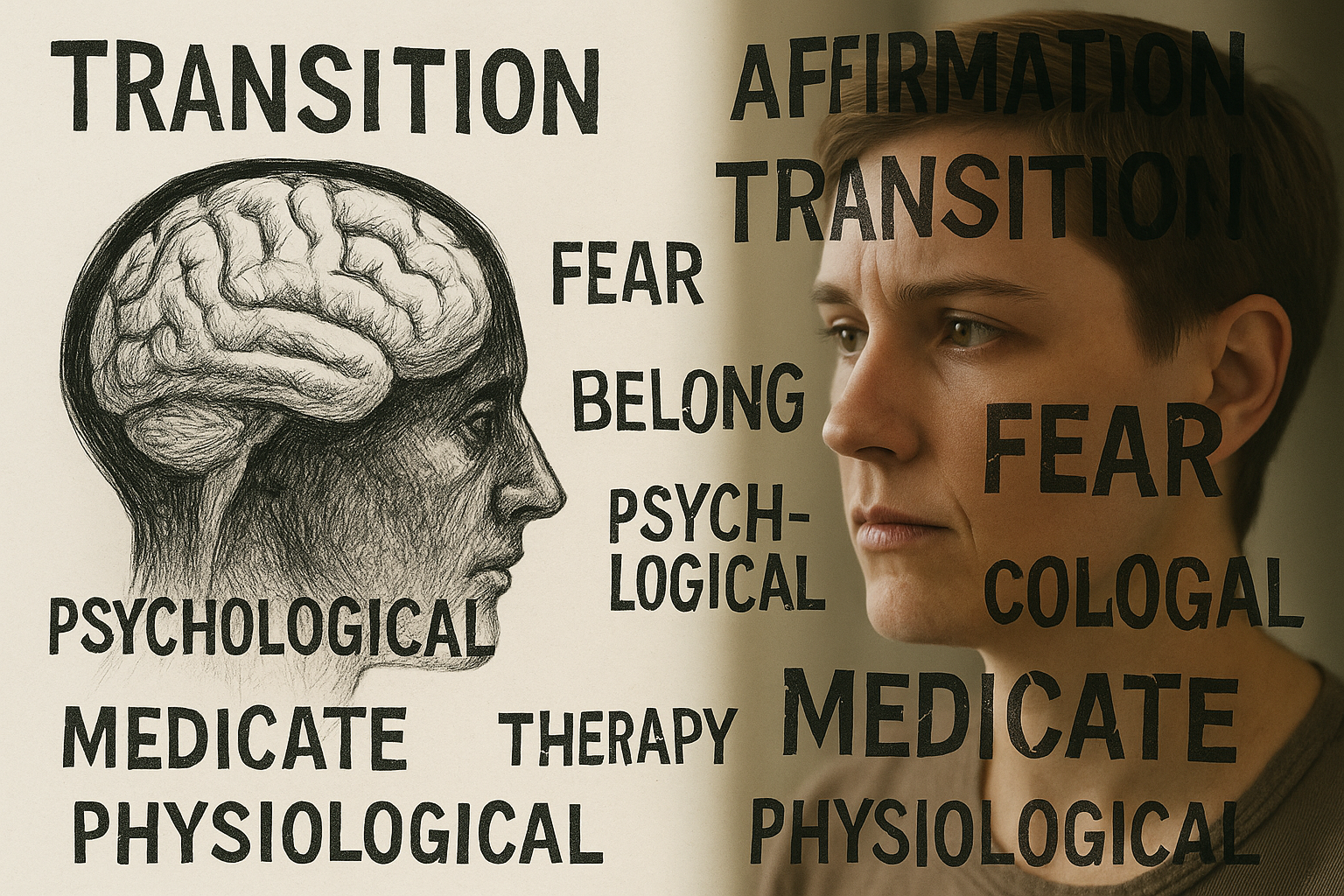The Science of Dysphoria || What We Know, What We Don’t

When it comes to gender identity and dysphoria, there’s a lot of talk, but not nearly enough clarity. The science is far from settled, and the stakes are too high to pretend otherwise.
We’ve gone from calling transgender identity a disorder (DSM-IV) to labeling it a form of psychological distress (DSM-5). At the same time, we’ve begun exploring medical interventions for children and teens without a full understanding of the long-term effects. And in too many cases, we’re letting ideology outrun evidence.
This article isn’t here to affirm or deny, it’s here to slow down the conversation and ask the most important question:
Do we really know what we’re doing?
The Science of Dysphoria || What We Know, What We Don’t

When it comes to gender identity and dysphoria, there’s a lot of talk, but not nearly enough clarity. The science is far from settled, and the stakes are too high to pretend otherwise.
We’ve gone from calling transgender identity a disorder (DSM-IV) to labeling it a form of psychological distress (DSM-5). At the same time, we’ve begun exploring medical interventions for children and teens without a full understanding of the long-term effects. And in too many cases, we’re letting ideology outrun evidence.
This article isn’t here to affirm or deny, it’s here to slow down the conversation and ask the most important question:
Do we really know what we’re doing?
From Disorder to Diagnosis: The DSM-IV vs. DSM-5
In 1994, the DSM-IV categorized transgender identity as Gender Identity Disorder, treating the experience of identifying with a different gender than one’s biological sex as a mental illness.
By 2013, the DSM-5 changed the diagnosis to Gender Dysphoria. The goal was to remove the stigma of identity itself and instead focus on the emotional distress that can come from feeling misaligned with one’s body.
It was a shift rooted in compassion—but it came with unintended consequences.
By taking the focus off identity as a diagnosable condition, we began treating how someone feels as reason enough to affirm, often without asking why they feel that way in the first place.
And that’s the problem.
If someone feels they were “born in the wrong body,” that distress is real, but the cause of it isn’t always the same.
- Sometimes it's neurological.
- Sometimes it's trauma.
- Sometimes it's social, emotional, or deeply personal.
But without careful evaluation, we can't know. And if we get it wrong, especially in children, the consequences are permanent.
We can respect identity while still asking hard questions about the source of someone’s pain. That’s not cruelty. That’s care.
Follow the Money: Insurance, Diagnosis, and Public Trust

When the DSM-5 reclassified Gender Identity Disorder as Gender Dysphoria, it wasn't solely a clinical decision. A significant driver behind this change was to facilitate insurance coverage for gender-affirming treatments.
By framing the condition as a form of distress rather than an identity disorder, the DSM-5 allowed counseling, hormone therapy, and surgeries to be recognized as medically necessary, and therefore covered by insurance.
That sounds reasonable. But it raises questions:
- If financial access shapes how diagnoses are written, how much of it is science, and how much is insurance coding?
To be clear, increasing access to care matters. But when medical classifications shift to fit billing structures, public trust takes a hit. We should always ask:
Are we helping people, or helping the system help itself?
What the Brain Studies Show, and Don’t Show
In 1995, Zhou et al. studied a brain region called the bed nucleus of the stria terminalis (BSTc) and found that in a small sample of male-to-female transgender individuals, it resembled that of cisgender women.
Many took this as biological proof of transgender identity. But the study had major limits:
- It didn’t prove causation
- It didn’t account for hormone influence
- It had an extremely small sample size
- And it wasn’t followed up with robust replication
Since then, newer imaging studies have found some trends—certain transgender individuals may show patterns in brain regions tied to self-perception and body awareness that align with their identified gender.
But:
- Results vary widely
- Patterns are not exclusive to transgender people
- Some cisgender individuals show them too
- Many transgender individuals don’t
- And nearly all studies have small sample sizes and methodological gaps
There is no known “trans brain.”
These are trends, not tests.
These early findings, while far from conclusive, are promising enough to demand deeper investigation. Both sides of the aisle should want clarity, because real lives depend on it.
Current Research: Still Searching for Solid Ground
Researchers today have better tools—fMRI, psychological testing, and data modeling—but we’re still early in the process.
For example, a 2018 study by Burke et al. showed that some transgender individuals have brain connectivity patterns in self-perception regions that resemble their identified gender. That sounds promising, and it is.
But the patterns are:
- Not universal
- Not predictive
- Not usable as diagnosis
- And not exclusive to transgender identity
One 2020 study linked childhood trauma to higher rates of dysphoria, but with only 42 participants, it lacked statistical power.
Even well-intentioned studies struggle with:
- Small, non-diverse samples
- Difficulty separating identity from coexisting conditions like trauma, depression, or autism
- Inconsistent definitions of “gender identity” in research settings
Still, the work being done is valuable, and needed.
If there’s a biological component, we need to find it. If there isn’t, we need to stop pretending we already have.
Until then, we must treat this topic with both empathy and rigor.

Youth Transitioning: What the Science Supports, and What It Doesn’t
There may be no more controversial question in the gender debate than this:
Should children and teenagers be allowed to medically transition?
Advocates say early intervention can save lives. Critics argue we’re rushing kids into irreversible changes without fully understanding the consequences.
Let’s look at what the science actually says.
Puberty Blockers: A Pause Button or a Gateway?
Blockers are often described as reversible, “time to think.” But:
- Few long-term studies track outcomes into adulthood
- Risks to brain development, bone density, and sexual function remain unclear
- And up to 97% of kids who start blockers go on to cross-sex hormones
That’s not a pause, it’s a path.
Cross-Sex Hormones: Irreversible and Young
Testosterone and estrogen are now prescribed to some kids as young as 13–14.
These hormones cause permanent changes:
- Voice deepening
- Breast growth
- Body hair
- Fertility loss
- And sometimes irreversible sexual side effects
Even WPATH admits the evidence for these interventions in minors is “low” or “very low” quality. Yet some clinics follow informed consent models, allowing access to hormones after a single visit with parental approval.
The Real Risk: Getting It Wrong
Some kids find peace through early transition. But some don’t.
A 2021 Lancet study found 1–2% of transitioned youth reported regret. Other estimates go higher.
Some say they were misdiagnosed.
Others say trauma, not gender, was the root of their pain.
When we move too fast, we risk treating the wrong wound.
Mental Health: A Complex Picture
Dysphoria is real. So is the mental health burden.
Some research shows early intervention can reduce short-term distress. But long-term impacts remain unclear, and transition may delay deeper healing in some cases.
What every child needs, no matter what path they take, is consistent, in-depth psychological support.
That should be the foundation, not the afterthought.
The Middle Ground: Caution, Not Cruelty
This isn’t about denying care. It’s about getting it right.
Until the science is stronger, the default shouldn’t be hostility, or blind affirmation.
It should be scrutiny, support, and care rooted in evidence.
Because when the stakes are lifelong, slowing down isn’t cruelty.
It’s compassion.
Detransitioning: Rare, Real, and Often Overlooked
One of the most ignored parts of the gender care conversation is detransitioning, when someone reverses their transition because they realize it wasn’t the right path.
It doesn’t happen often. But when it does, it matters.
How Common Is It?
- The Lancet (2021): 1–2% of transitioned youth report regret
- Other studies: as high as 5–13%, especially with longer follow-up
- Detrans communities online have exploded in recent years
These stories aren’t anti-trans.
They’re reminders that not everyone who transitions is helped by it.
Why People Detransition
- Misdiagnosis
- Trauma-based dysphoria
- Social pressure
- Sterility or side effects
- Or simply not feeling better after transition
Many say they were affirmed too quickly, with no alternative paths seriously offered.
And when they choose to step back?
The system often doesn’t know what to do with them.
They Deserve to Be Heard
Detransitioners aren’t political weapons.
They’re people. And they deserve the same empathy and support as anyone else in pain.
Detransitioning doesn’t invalidate transition.
It shows why every step in this process must be careful, thoughtful, and honest.
We don’t have all the answers. But we owe it to everyone—those who transition, those who don’t, and those who reverse course—to keep asking the right questions.
Citations
- American Psychiatric Association. (2013). Diagnostic and Statistical Manual of Mental Disorders (5th ed.). https://doi.org/10.1176/appi.books.9780890425596
- Zhou, J.-N., Hofman, M. A., Gooren, L. J., & Swaab, D. F. (1995). A sex difference in the human brain and its relation to transsexuality. Nature, 378(6552), 68–70. https://doi.org/10.1038/378068a0
- Kruijver, F. P. M., et al. (2000). Male-to-female transsexuals have female neuron numbers in a limbic nucleus. J Clin Endocrinol Metab, 85(5), 2034–2041. https://doi.org/10.1210/jcem.85.5.6564
- Burke, S. M., Manzouri, A., & Savic, I. (2018). Structural connections in the brain in relation to gender identity and sexual orientation. Scientific Reports, 8(1), 1–10. https://doi.org/10.1038/s41598-018-20339-y
- * Littman, L. (2018). Parent reports of adolescents and young adults perceived to show signs of a rapid onset of gender dysphoria. PLOS ONE, 13(8), e0202330. https://doi.org/10.1371/journal.pone.0202330
(*Note: This study is hypothesis-generating and based on parent reports only. It has been revised to clarify its limitations.)